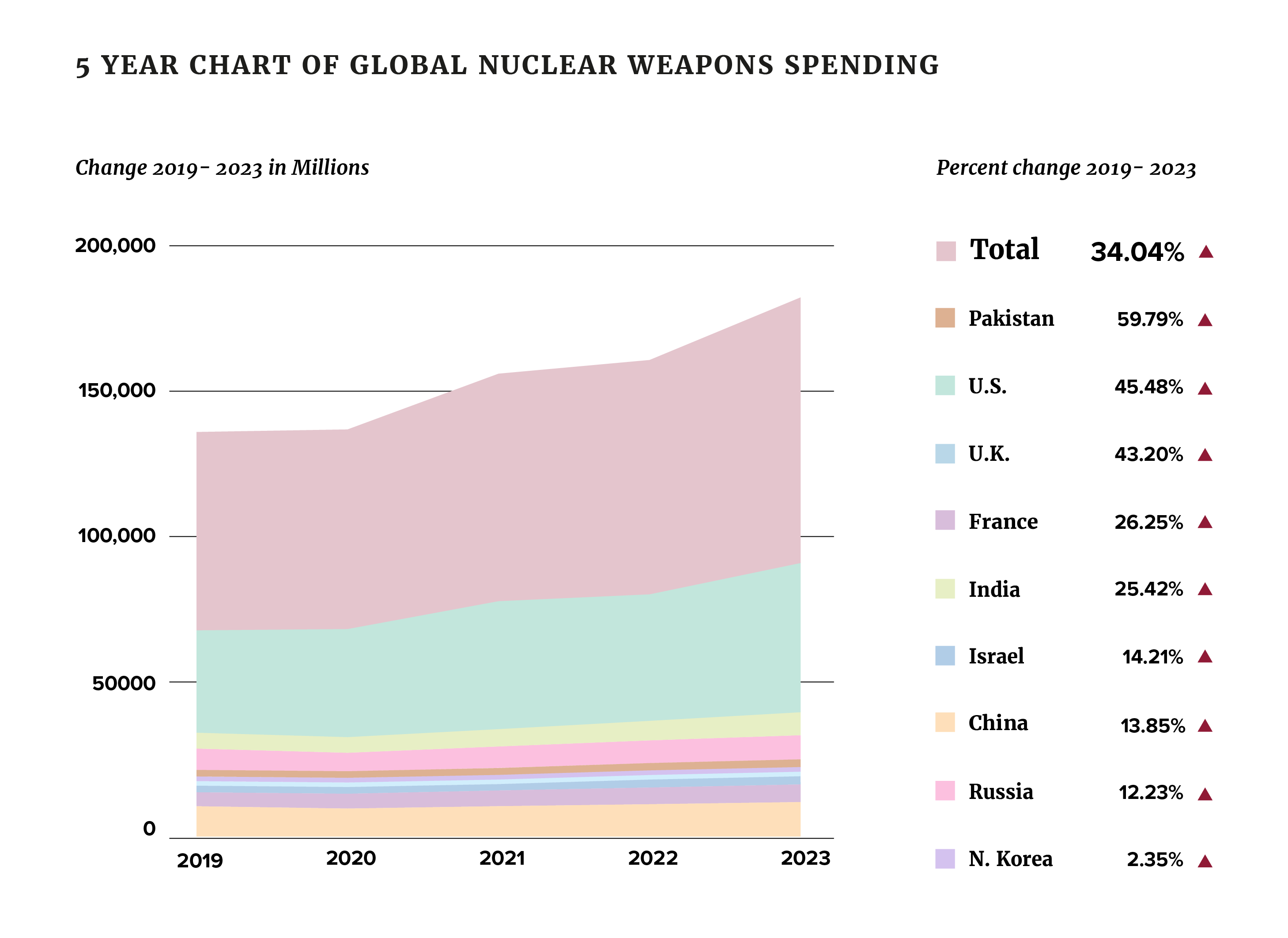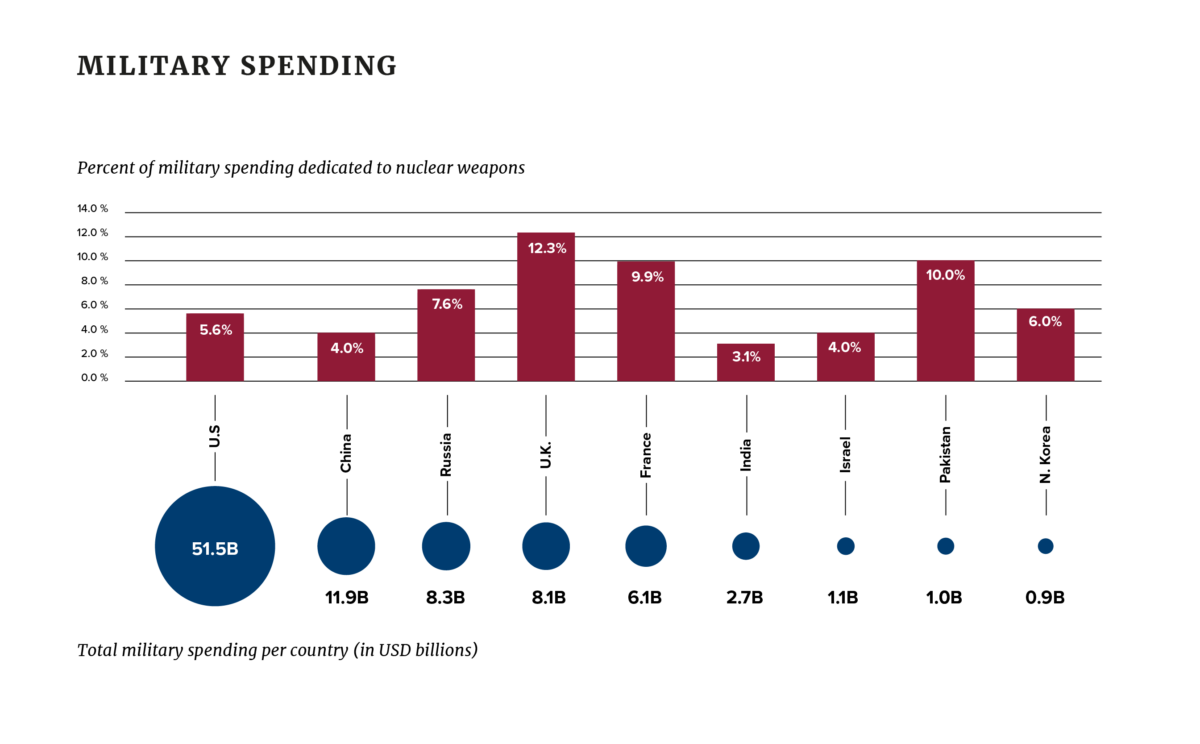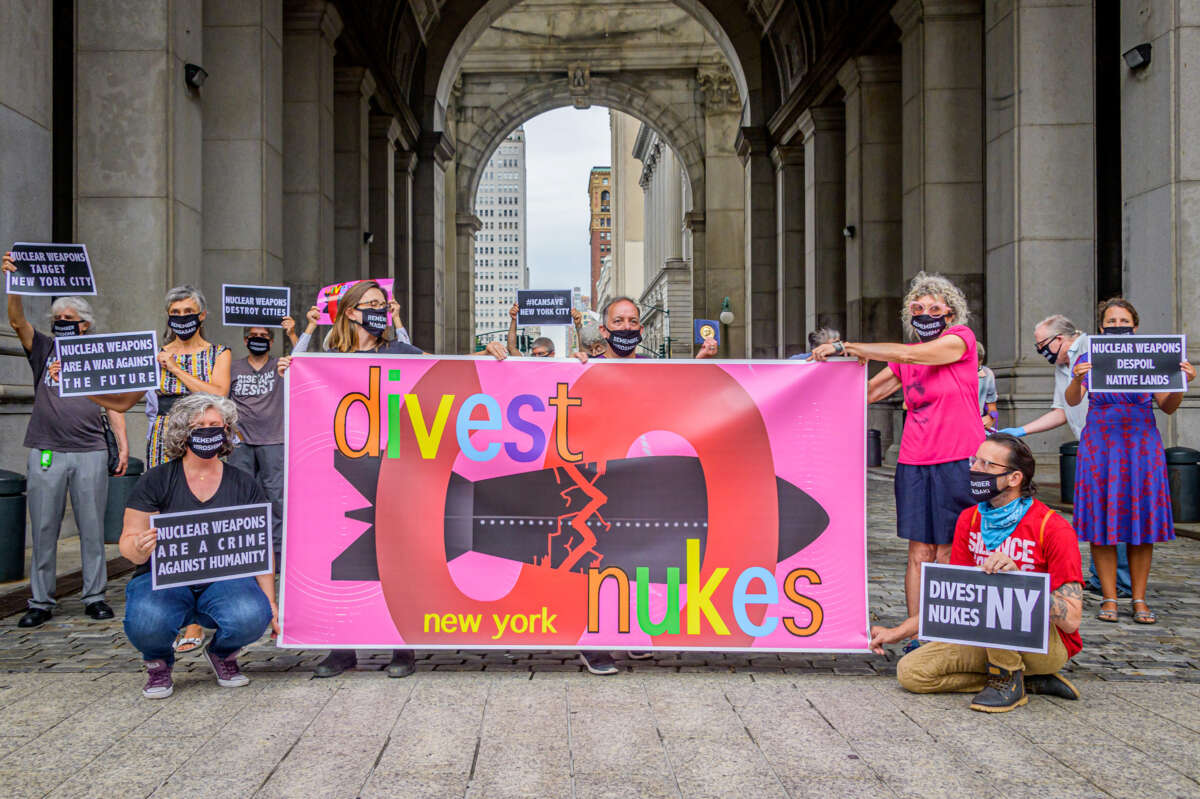As raging wars in Gaza and Ukraine and sharpening geopolitical tensions fuel instability and uncertainty, global spending on nuclear weapons surged by more than 13 percent to $91.4 billion in 2023, according to a newly published report by the International Campaign to Abolish Nuclear Weapons (ICAN).
According to the report, last year the world’s nine nuclear-armed nations all increased spending on their arsenals at a rate equivalent to $250 million per day. The largest rise in nuclear spending was by the United States, with a nearly 18 percent increase over 2022 to $51.5 billion — the equivalent of nearly $98,000 per minute — more than the other eight countries combined.
As the U.S. continues to modernize all three legs of its nuclear triad (bombers, submarines and intercontinental ballistic missiles), in 2023, it spent more than four times the amount spent by China, the second-highest-ranked nuclear nation.
By comparison, China increased its spending on nuclear weapons 6.7 percent to $11.9 billion, followed by Russia at $8.3 billion, the third-highest spender. Both the U.S. and Russia have a total inventory of more than 5,000 nuclear weapons. With 500 of its own nuclear weapons, China remains a distant third, but analysts say it is “significantly expanding” the size of its arsenal.
France and the United Kingdom increased nuclear spending to $6.1 billion and $8.1 billion respectively, and while France’s nuclear budget swelled by 5.7 percent, U.K. nuclear spending grew by 17.1 percent, three times more than France.
Global spending on nuclear weapons surged by more than 13 percent to $91.4 billion in 2023.
At the lower end of the scale, India, Pakistan and North Korea spent $2.7 billion, $1 billion and $856 million respectively. Israel, which has a longstanding policy of ambiguity, neither confirming nor denying its nuclear weapons program, spent $1.1 billion in 2023, according to the report.
ICAN, which has been monitoring global nuclear weapons spending since 2019, reports that total spending has increased by 34 percent ($23.2 billion) over the last five years. That works out to a cumulative total of $387 billion for nine nuclear-armed nations to maintain, modernize and expand nuclear arsenals over five years. During that period, all nine have consistently increased their nuclear spending.
The report notes that in 2021 the executive director of the World Food Programme estimated that global hunger could be eradicated by 2030 for $360 billion, $27 billion less than what the nine nuclear nations spent in five years.

Lobbying and Profiting
At the heart of the sharp rise in nuclear weapons spending are multinational corporations. Some are household names, but most are unknown to the public. For these companies and their shareholders, the production of nuclear weapons generates tens of billions of dollars in profits.
ICAN’s report offers detailed summaries of 20 prominent companies which in 2023 spent over $118 million to lobby government officials and support think tanks. Last year these companies gained almost $8 billion in new contracts that support the nuclear weapons enterprise in multiple countries.
Last year the world’s nine nuclear-armed nations all increased spending on their arsenals at a rate equivalent to $250 million per day.
Top ranked among the 20 companies included in the report were Honeywell International ($6.1 billion), Northrop Grumman ($5.9 billion) and BAE Systems ($3.3 billion) based on reported 2023 nuclear weapons-related revenue.
Honeywell, which builds key components for missiles designed to carry nuclear weapons, also supports management and operations of multiple U.S. nuclear weapons production facilities. According to the ICAN report, in 2023, the company spent over $10 million lobbying in France and the U.S.
Northrop Grumman, one of the world’s largest weapons manufacturers, plays a central role in nuclear weapons production, including Sentinel, the replacement for the aging Minuteman III intercontinental ballistic missiles (ICBM), which is mired in cost overruns. In its own news release, Northrop Grumman reported a $426 million sales increase in 2023 for the program that will replace the Minuteman III, which are housed in underground silos in Colorado, Montana, Nebraska, North Dakota and Wyoming.
Honeywell and Northrop Grumman did not respond to Truthout’s requests for comment.
Other well-known corporations produce “key components for the French nuclear arsenal” (Airbus), a “guided tail-kit assembly for the [U.S.] B61-12 nuclear gravity bomb” (Boeing), and maintain “propulsion systems for all U.K. nuclear-armed submarines” (Rolls-Royce).
The report breaks down which companies support which weapons systems or facilities in which countries. It also provides a summary of efforts to lobby and influence policy in ways that favor new contracts and increased profits.

What Can Be Done?
Susi Snyder, program coordinator of ICAN and co-author of the report, told Truthout that the average citizen, contemplating the astronomical amounts being spent on apocalyptic weapons that exist out of the public eye, should understand this is tens of billions of taxpayer dollars being spent on a handful of companies that are making a profit for their shareholders.
At the heart of the sharp rise in nuclear weapons spending are multinational corporations. For these companies and their shareholders, the production of nuclear weapons generates tens of billions of dollars in profits.
Speaking from Geneva, Snyder said the companies “are in some ways really milking a system … with a false justification.” She called the report “one tool to uncover the myth of nuclear weapons,” which she said are not useful and do not provide security, but rather put everyone at risk.
With the money spent last year by nine countries on nuclear weapons in just one minute, Snyder said a million trees could be planted to address the climate crisis and environmental issues.
“Imagine a million trees,” she said, “instead of bombs that are designed to vaporize those cities. People need to think of the alternatives, and they need to say something about it.”
Every voice that speaks out against nuclear weapons has an impact, Snyder said, no matter how big or small that voice.
Compared with the U.S. spending $98,000 per minute on nuclear weapons in 2023, in 2021 U.S. public schools spent an average of $14,347 per student for an entire year, according to the U.S. Census Bureau.
Mackenzie Knight, program associate with the Nuclear Information Project of the Federation of American Scientists, told Truthout that the report’s findings reflect the trends she and her colleagues have been seeing in their own nuclear weapons research.
Knight said the report, combined with other forms of research, can help the public better understand the greater context of today’s nuclear landscape. She pointed to the fact that all nine nuclear-armed nations are modernizing their arsenals (improving existing weapons systems, building new systems and introducing new capabilities). Understanding this — alongside decreased nuclear transparency, the collapse of arms control treaties, increased focus on “tactical” or “battlefield” nuclear weapons, as well as heightened nuclear rhetoric — can provide a more complete picture of what the surge in nuclear spending means.
Knight added that as burgeoning cost overruns on controversial nuclear programs gain more attention from members of Congress, ordinary citizens have an opportunity to voice their concerns to their elected representatives who cast votes that determine the allocation of defense budgets and can advance or suspend multibillion-dollar nuclear programs.
Compared with the U.S. spending $98,000 per minute on nuclear weapons in 2023, in 2021 U.S. public schools spent an average of $14,347 per student for an entire year, according to the U.S. Census Bureau.
“They have real power in talking to their representatives and letting them know that they’re aware of these issues and that their representatives should be among those who are being outspoken,” Knight said.
“We Don’t Need More Nuclear Weapons”
In recent years, politicians in Russia, Israel, North Korea and, during the Trump administration, the United States, have made explicit nuclear threats. As president, Donald Trump warned of “fire and fury,” threatening to destroy North Korea and Iran with missiles that are “big, powerful, accurate, lethal, and fast.”
In 2019, while campaigning for the presidency, then-candidate Joe Biden told an audience, “We don’t need more nuclear weapons, period.”
In fact, under both Trump and Biden, the U.S. has continued to modernize its nuclear weapons. This month, The New York Times reported that a senior Biden administration official said the U.S. might have to consider the possibility of expanding its own arsenal. “Absent a change in the trajectory of adversary arsenals, we may reach a point in the coming years where an increase from current deployed numbers is required,” said Pranay Vaddi, special assistant to the president and senior director for Arms Control, Disarmament, and Nonproliferation at the National Security Council. Although his remarks were speculative, such a move would be a major reversal after decades of reducing the total number of nuclear weapons from its peak in the 1960s.
Speaking at the same annual meeting of the Arms Control Association, Executive Director Daryl Kimball said, “despite this immense and expensive array of nuclear firepower and the booming cost of the current modernization program, contractor lobbyists, defense-industry affiliated think tanks, and some members of Congress want even more.”
Building up the U.S. deployed nuclear arsenal, Kimball said, would be “dangerously counterproductive and prohibitively expensive.”
Addressing the same audience, congressman John Garamendi (D-California) said, “we have fallen into the fallacy that more missiles make us more secure. Nothing could be further from the truth.”
Findings in a new YouGov survey on nuclear weapons indicate many Americans share these views. When asked, 49 percent of respondents agreed that “no one should have nuclear weapons.” In the same survey, 63 percent said nuclear weapons make the world more dangerous.
These findings suggest that many Americans support a 2022 joint statement by leaders of the world’s five officially recognized Nuclear Weapon States who declared that “a nuclear war cannot be won and must never be fought,” echoing a U.S.-Soviet statement dating back to the Cold War.
Meanwhile, as nine nuclear-armed nations pour hundreds of billions of dollars into weapons they hope they will never use, 70 countries have ratified the Treaty on the Prohibition of Nuclear Weapons, which was adopted in 2017 with support from 122 countries. And while the spending on nuclear arsenals continues to grow, so too does the number of countries that view nuclear weapons as illegitimate, immoral and illegal under international law.
Media that fights fascism
Truthout is funded almost entirely by readers — that’s why we can speak truth to power and cut against the mainstream narrative. But independent journalists at Truthout face mounting political repression under Trump.
We rely on your support to survive McCarthyist censorship. Please make a tax-deductible one-time or monthly donation.
